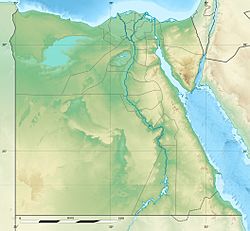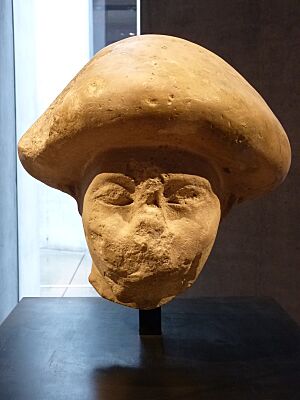Avaris facts for kids

Map of ancient Lower Egypt showing Avaris
|
|
| Location | Sharqia Governorate, Egypt |
|---|---|
| Region | Lower Egypt |
| Coordinates | 30°47′14.7″N 31°49′16.9″E / 30.787417°N 31.821361°E |
| Type | Settlement |
Avaris was an important ancient city in Egypt. It was the capital city for a group of rulers called the Hyksos. Avaris was located in the northeastern part of the Nile Delta, which is where the Nile River splits into many branches before reaching the sea. The city was a major center for trade because it was right on the Nile. People lived there from about 1800 BC until it was taken over by an Egyptian pharaoh named Ahmose I.
Discovering Ancient Avaris

In 1885, a Swiss explorer named Édouard Naville began the first digs in the area where Avaris once stood. Later, in the 1940s, an Egyptian expert named Labib Habachi suggested that this site was indeed Avaris.
Since the 1960s, a team from Austria has been carefully digging at the site. In 2010, they used special radar technology. This helped them see the outlines of the ancient city without even digging! They found streets, houses, a busy port, and even a part of the Nile River that used to flow through the city.
Today, the site of Avaris, called Tell el-Dab'a, is mostly ruins. But the excavations show it was once a very busy trading hub. Its harbor could handle over 300 ships during trading season! Digs at a temple from the Hyksos period have uncovered items from all over the Aegean Sea region. There were even wall paintings that look like those found in the Minoan palace of Knossos on the island of Crete.
A City Through Time
Avaris was first started by an Egyptian pharaoh named Amenemhat I. It was built on an eastern branch of the Nile River. Because it was close to Asia, many people from Asia moved there. These immigrants often adopted Egyptian ways, like using Egyptian pottery. But they also kept some of their own traditions, which can be seen in their burials, where weapons from their homelands were found.
Around 1800 BC, the Hyksos took control of Lower Egypt and made Avaris their capital. An Egyptian pharaoh named Kamose tried to capture Avaris, but he couldn't defeat the Hyksos. However, a few decades later, Ahmose I finally captured the city and drove out the Hyksos. Even after the Egyptians took back control, many people from the Middle East continued to live in Avaris.
Later, the pharaohs of the Eighteenth Dynasty moved their capital to Thebes. Avaris became less important for a while. But some parts of the city, like the Temple of Seth, were still used.
Much later, a pharaoh named Ramesses II built a new capital city called Pi-Ramesses very close to Avaris. Because of this, Avaris was eventually abandoned. Parts of the old city were even used as a cemetery. However, the harbor of Avaris remained important and was still used as a major navy base.
A Link to the Minoans
Avaris is special because it shows connections to the Minoan civilization. The Minoans were an ancient culture from the island of Crete. It's rare to find Minoan traces in Egypt, but Avaris has them!
Archaeologists found parts of Minoan-style wall paintings in Avaris. These paintings are very similar to those found in the famous palace of Knossos on Crete. Some experts believe that Minoans had a strong connection with the rulers of Avaris. They might have even had a special place in Avaris to practice their own rituals. This suggests a close relationship between these two ancient cultures.
See Also
- List of ancient Egyptian towns and cities
- List of historical capitals of Egypt
|



